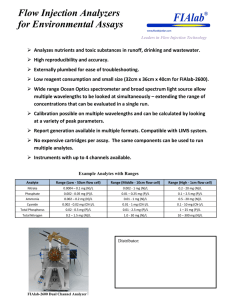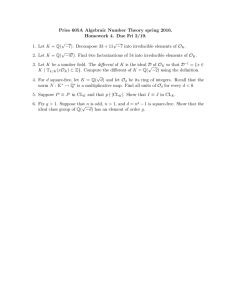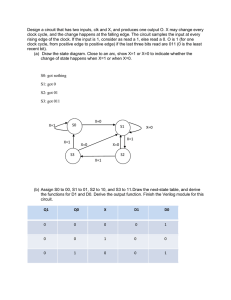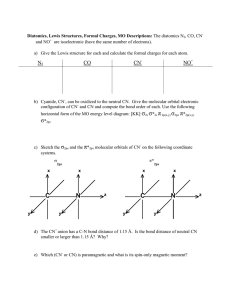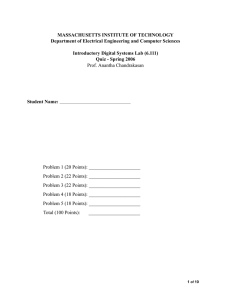MASSACHUSETTS INSTITUTE OF TECHNOLOGY Department of Electrical Engineering and Computer Sciences
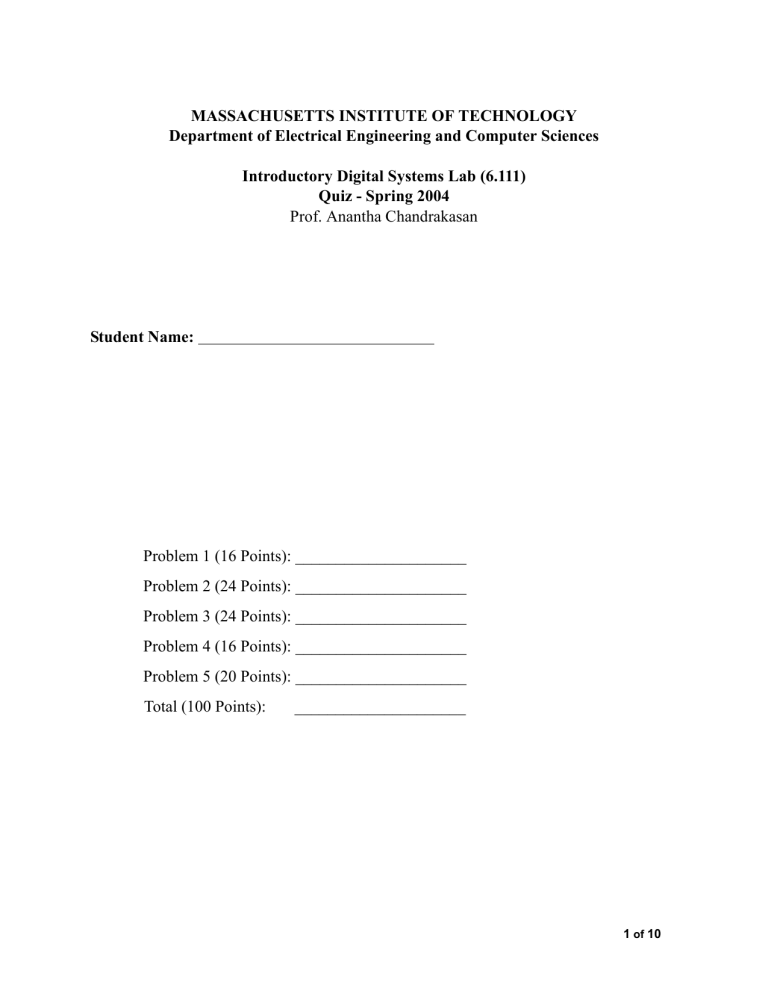
MASSACHUSETTS INSTITUTE OF TECHNOLOGY
Department of Electrical Engineering and Computer Sciences
Introductory Digital Systems Lab (6.111)
Quiz - Spring 2004
Prof. Anantha Chandrakasan
Student Name:
Problem 1 (16 Points): _____________________
Problem 2 (24 Points): _____________________
Problem 3 (24 Points): _____________________
Problem 4 (16 Points): _____________________
Problem 5 (20 Points): _____________________
Total (100 Points): _____________________
1 of 10
Problem 1: Sequential Building Block Characterization:
Consider the following implementation of a register. Assume that an inverter has a delay of 1 and that the switch is ideal. The switch is closed when the control input is high.
CLK CLK
D
CLK
CLK
Q
Master (inverting) Latch
(a) What type of register is shown above (circle one)?(4 points) positive edge-triggered negative edge-triggered
Slave (inverting) Latch
(b) What is the setup time (t su
), hold time (t hold
), and propagation (t cq
) delay. Assume that CLK and CLK are ideal (i.e., the delay to derive CLK from CLK is zero). (12 points)
2 of 10
Problem 2: Clock Gating Circuit
Assume for the entire problem that the counter reset is synchronous.
(a) Consider the one second clock from lab2. The 1Hz enable is derived from the circuit below (the clock is the 1.8432Mhz clock). Assume that a global reset signal puts the count to 0 (the circuit is not shown here). Suppose the 1Hz enable is used to clock other circuits that need to be updated once per second (e.g., the register shown below). Identify the main problem with this circuit. (4 points) register
In D Q Out
1Hz Enable reset
CLK
Q
Count[20:0]
21
Combinational
Logic (comparator)
=
21’d1843199
(b) The following is a simple modification that is proposed to solve the problem of part (a). The counter is negative edge-triggered and the AND gate is introduced before the register clock. Assume that the AND gate is ideal (i.e., has zero delay). Does this circuit fix the problem of part (a)? If so, under what conditions does this circuit function properly? If not, explain why. (6 points) register
In D Q Out
1Hz Enable reset
Q
Count [20:0]
21
Combinational
Logic (comparator)
=
21’d1843199
CLK
CLK
3 of 10
(c) The solution of (b) is not a synchronous one (i.e., a single global clock to every register). Propose a fix to the problem in part (a) using a single clock (CLK). That is, both the counter and register are clocked from the same clock (CLK). The signal In should be loaded into the register once per second. You may add additional components in the diagram below. (6 points)
1Hz Enable reset
CLK
Q
Count [20:0]
21
Combinational
Logic (comparator)
=
21’d1843199
In register
D Q Out
CLK
(d) For each of the following signals, specify if glitches are allowed. (circle one) (8 points)
(i) Data lines to the M6264 when
writing (when W is low, G is high, chip is enabled)
as long as it settles well before W goes high
Glitches Not Allowed Glitches are Allowed
(ii) Address lines to the M6264 when
reading (when W is high, G is low, chip is enabled)
as long as it settles well before the output
data is required
Glitches Not Allowed Glitches are Allowed
Glitches Not Allowed Glitches are Allowed (iii) R/W for the AD670 (ADC)
when CE and CS are low
(iv) Data inputs for the AD558 (DAC)
when CE and CS are low
Glitches Not Allowed Glitches are Allowed
4 of 10
Problem 3: Arithmetic
(a) Consider the following 16-bit Carry Bypass Adder. Assume that the Sum Logic (SL) block for stage i has as inputs P i
, G i
, and C in,i
. Assume the following delays:
• Delay to produce the P i
, G i
signals from the A i
, B i
inputs is 1 (i.e., the delay of the PG logic block)
• Delay to compute C out_i
from P i
, G i
and C in,i
inputs is 1 (i.e., the delay of the Carry Logic (CL) block)
• Delay to compute S
i from C in,i
, P i
, G i
being valid is 2 (i.e., the delay of the Sum Logic (SL) block)
• Delay for the 2:1 multiplexor is 2
• Delay to compute the group propagate, GP i
, is 1
Highlight the critical path for this 16-bit adder directly on figure below (6 points)
A
0
B
0
A
1
B
1
A
2
B
2
A
3
B
3
A
4
B
4
A
5
B
5
A
6
B
6
A
7
B
7
A
8
B
8
A
9
B
9
A
10
B
10
A
11
B
11
A
12
B
12
A
13
B
13
A
14
B
14
A
15
B
15
PG PG PG PG PG PG PG PG
C in,0
CL CL CL CL
0
1
CL CL CL CL
0
1
PG PG PG PG PG PG PG PG
CL CL CL CL
0
1
CL CL CL CL
C out,15
SL SL SL SL SL SL SL SL SL SL SL SL SL SL SL SL
S
0
S
1
S
2
S
3
S
4
S
5
S
6
S
7
S
8
S
9
S
10
S
11
S
12
S
13
S
14
S
15
(b) Based on the structure in (a), assuming a block size equal to 4, write down an equation for the delay of an N input adder, where N is a multiple of 4. (6 points)
5 of 10
(c) Consider a 64-tap filter implemented using an accumulator architecture as shown below. How many bits will be required for the adder? (6 points)
reset_accumulator
?
In
(twos complement)
8-bits
Coefficient
(twos complement)
Twos
Complement
Multiplier
8-bits
16-bits
Twos complement, sign extended to match the adder width
+
?
D Q
CLK
(d) There is an error in the following implementation of the carry out logic. Identify the error and propose a simple solution (it might involve changing the logic). (6 points)
A B
A
B
C in
0
1
C out
6 of 10
Problem 4: FPGA
(a) Consider an FPGA architecture with three identical 4-input SRAM based lookup tables. For this problem do not worry about the circuits to perform the write operation into the SRAM. Each SRAM is shown to have 4 inputs (i.e., address bits) and one output bit. Draw the circuit diagram for using the three SRAMs shown below to implement an arbitrary function Y of 5-input variables in
4
, in
3
, in
2
, in
1
, in
0
? Do not add any additional components. (8 points)
SRAM1 in
4 in
3 in
2 in
1 in
0
A
3
A
2
A
1
SRAM3
A
0
Y
SRAM2
7 of 10
(b)What is the function implemented by SRAM3 corresponding to your solution in part 4(a)? Explain. (8 points)
8 of 10
PROBLEM 5: Verilog
(a) Consider the follow piece of code to implement a synchronizer (with two registers). Does the code implement the required functionality? (explain). If the code does not properly implement a synchronizer, modify the code as necessary. (6 points) input in; reg q1, q2; always @ (posedge clk) begin
q1 = in;
q2 = q1; end
(b) The following Verilog code should synthesize to a purely combinational logic function (3:1 multiplexor, where we don’t care about the case when sel = 11). Does it? If not, fix the code so that there are no
memory elements. (6 points) module mux_3to1 (a, b,c, sel, out); input [1:0] sel; input a,b, c; output out; reg out; always @ (a or b or c or sel) begin
case (sel)
2’b00: out = a;
2’b01: out = b;
2’b10: out = c; endcase
end endmodule
9 of 10
(c) A simple digital system consists of a four state FSM which increments a 4-bit synchronous counter when the FSM is in state 10. An asynchronous reset signal is used to force both the state machine and the counter to all zeros whenever it is high. Identify the major problem with this code when synthesized and propose a fix (i.e., make the necessary modifications to the code below. You may add a control signal). (8 points) module simple_fsm(clk, reset, count);
input reset, clk;
output [3:0] count;
reg [3:0] count;
reg [1:0] state;
reg [1:0] next;
always @ (posedge clk or posedge reset) begin
if (reset)
begin
state <= 2'b00;
end
else
begin
state <= next;
end
end
always @ (state or reset) begin
if (reset)
count = 4'b0000;
case (state)
2'b00: next = 2'b01;
2'b01: next = 2'b10;
2'b10: begin
next = 2'b11;
count = count +1;
end
2'b11: next = 2'b00;
endcase
end //always
endmodule
10 of 10
